Landing in Yangon on my previous trip I remember feeling that I had stepped into the Indian Subcontinent, such were the reminiscent similarities in sights, sounds and especially smells. This time however I felt that we were arriving in a land so completely different from any other in the same area. In this sense the country that I have been reminded of most often during the past three weeks has actually been Ethiopia, as it shares the same distinction as Myanmar of being completely different in all ways from its neighbouring countries. It is true though that Burma, as the country was previously known, bridged the gap between the Subcontinent and South East Asia in more ways than merely geographical. This is in part due to the British colonial governors shifting Indian labour forces around the Empire, many of whom settled in Burma and survived the Socialist and Nationalist periods which saw many Chinese and Indian families being forced to leave, Idi Amin style.
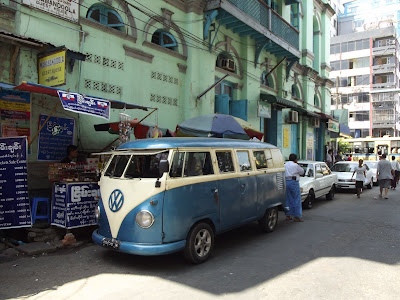
We were relieved to find a vacant room at the Mahabandoola Guest House, which hasn’t changed in the intervening years and alongside Sweety in Bangkok is still one of my favourite decrepit guest houses that I would always stay at, regardless of my budget. Relieved, because we had read many scare stories in the Western media in recent months of a severe accommodation shortage in Myanmar, Yangon especially. Due to the necessity of a special licence that hotels must acquire in order to open to foreign guests the massive increase of visitors to Myanmar has stretched Yangon to bursting point. I am not really sure how it happens, how is it that as soon as the tyrannical government makes a few small reforms suddenly a quarter of a million tourists make the snap decision that this year they will visit Myanmar? Of course many of the visitors are coming as part of aid work, NGO’s or even looking at business interests but the rest are tourists, lured in by tales of a weird and wonderful land spun by their travel agent. The fact is though it is all true and any travel agent should not have to work too hard to sell the attraction of a trip to Myanmar!

The showpiece of Yangon and perhaps the whole country is the Shwedagon Paya, the giant Buddhist stupa built on a hill overlooking Yangon (Dagon being the ancient name of the city and ‘Shwe’ meaning something like ‘holy’ or ‘auspicious’). It is a bit of a trek to walk up there from the centre but once you reach the top you can sit there for hours, watching the crowds of locals on a visit, groups of young novice monks and the volunteer cleaners that sweep the entire floor each evening. Every five seconds as you wander around you cannot help but emit a ‘Wow’ at each and every new angle and viewpoint. It is easily the most impressive religious site that I think I have visited (of course I have never been to Mecca).

By contrast downtown Yangon is busy and crowded, everyone conducting their commerce on the streets and pavements underneath the decaying colonial buildings towering over. Is Yangon the only city in the world to have a giant gold Buddhist stupa on its main roundabout? The Sule Pagoda marks the centre of the city with all the primary roads fanning out from there – the city hall on the corner of Sule Paya Road, the market of Bogyoke Aung San Street, the Indian traders and restaurants of Anawratha Street and the dodgy money changers lurking around the Mahabandoola gardens.
With this mass increase in tourism I had been worried that it would have a negative effect on famous friendly welcome offered by virtually all Burmese and supported by the “Warmly Welcome Tourist” signs dotted around the country. But no, we still received an amazing reception, people going out of their way to greet and help us – for example when we got lost on the No.43 bus heading to the bus station a girl got off the bus with us, took us on a bus going the opposite way, paid for our tickets, got off the bus with us and walked us to the station before getting back on a bus going in her original direction and continuing her journey. This is not even an unusual occurrence; every visitor has their own stories of the kindness they encountered. Even the bus conductors who haggle with you over the fare in accordance with the “foreigner pricing” system will then afterwards take care of you, show you where to go, and constantly ask if you are OK. In restaurants we were constantly being given free desserts and extra drinks and in guesthouses it is impossible to leave in the morning without the owner ensuring you are OK and you know where you are going and so on, and often a free bottle of Star Cola or even a fresh Strawberry smoothie would suddenly appear. Finally, it is amazing how every single person you meet gives you a warm smile – after three weeks our cheeks are aching from so much smiling, the one reason we will be happy to get back to Thailand, give those face muscles a bit of a rest!

Our first stop heading north from Yangon was at the ancient city of Bagan, with the ruins of over 4000 temples spread out across the plains. It is truly an incredible sight, not because of the beauty of the individual temples but simply the sheer number of them. Gazing from the top of one of the temples you could be forgiven for thinking you can see all the other 4000 dotted around. On my previous visit I was one of only two tourists in town at the time (a combination of not such a popular time for the government and also it being monsoon season), this time we were joined by legions of explorers on rickety push-bikes and a surprising number of luxury coach tours. However sites are spread out over such an area that it is very easy to find a temple which no-one else has probably visited for a week or two and the only time we felt their presence was when we all chose the same sunset spot. Ironically there was no actual sunset as a dusty cloud had sat over Bagan and Mandalay for about two weeks, giving the sky a resemblance of a West African harmattan.
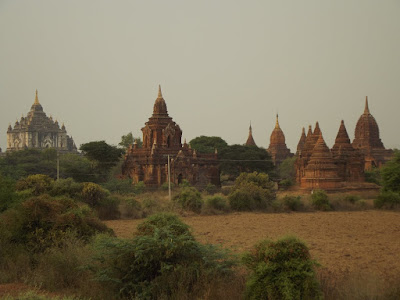
One aspect of travelling in Myanmar which used to be at the forefront of every visitors mind, and which was serviced by a 10-page discussion in the front of all guide books, was whether or not tourists should visit Myanmar and if they do then how to avoid paying the government any money. At the simplest level this means staying in local guesthouses, eating at stalls or small cafes and travelling by pick-up or local buses. Many hoteliers and guides are also pretty adept at finding ways to avoid government entrance fees. However we were shocked to find that many tourists were no longer mindful of where their money was going. I know the government have made some strides towards democracy but they are far from finished yet. It was disappointing to see people using trains, planes and government hotels, and the worst of all are the luxury package tourists that spend several thousand dollars on luxury tours run by government sponsored agencies. We kept up our end of the bargain by travelling in our usual manner and by avoiding as many fees as possible –in some places this was easy – no one even asked to see our $10 Bagan ticket for instance, which was lucky as we didn’t have one! – and in other places we relied on the help of local guides, preferring to send the money their way. Talking of dollars, all hotels and fees must be paid in US dollars and they must be totally crisp and clean, even the slightest fold or blemish and they will be rejected. This has started a new craze on the Khao Sanh road of backpackers touring the various exchange offices and clearing them out of any nice new greenbacks.
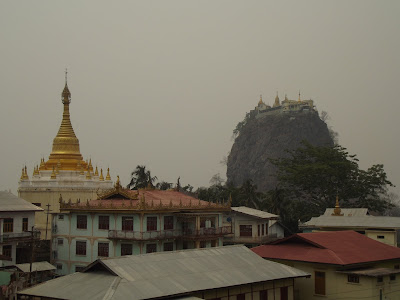
Close to Bagan is the strange shaped Mt Popa, and on top of it the shrine dedicated to the 37 nat (spirits) which is a major pilgrimage site. It is easily accessible from Bagan by small pick-up trucks that drop you at the base, from where it is a sweaty half-an-hour walk to the top. Red or black clothes must not be worn, meat must not be carried and no curses or insults must be uttered whilst climbing as this can anger the nat. This is classic Burmese Buddhist tourism. In all honesty I was underwhelmed by the shrine itself but the views from the top were pretty impressive and the views of the mountain from the surrounding hills made the trip worthwhile.
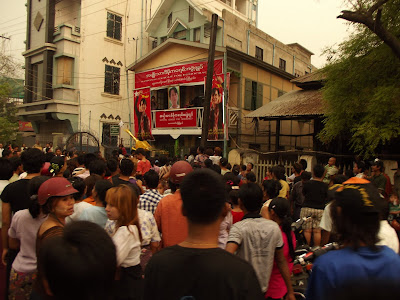
When reading the press reports of the April 1st by-elections one could be forgiven for thinking it a macabre April Fool’s joke. This was the first free multi-party elections since those in 1990 which the NLD (National League for Democracy) won by a landslide, prompting the government to crack down hard and these by-elections ended in a predictable repeat of that victory. Only this time it appears the military government are willing to cede some power. We arrived in Mandalay just as the election results were being announced and the pick-up taking us from the bus station to the centre detoured via the NLD office to hear Aung San Suu Kyi make a speech, broadcast from Yangon. The streets were full of crowds in celebration, everyone wearing Suu Kyi or NLD t-shirts and waving the flags of the party. This is probably the biggest change I could recognise over the past 9 years. Previously photos of Suu Kyi, NLD logos or flags and in fact the party itself were all banned, driven underground. Now every restaurant, hotel and bus has a photo of Suu Kyi next to the ubiquitous photo of Bogyoke Aung San, her father and the father of Burmese independence. There is no longer only the propaganda of the ‘New Light of Myanmar’ but many independent newspapers, all of which are open and honestly critical of the government. And it is amazing to see Burmese reading; everyone seems to be reading something, all the time, which is actually a very unusual sight in Asia. I wonder if it because they were not able to read such things before and now they can do so in the street. I was concerned before that the changes made were perceived by the West and by tourists to be greater than they actually are but actually these changes are very real and it is amazing to hear how people are really quite optimistic about the future – many times I heard the belief uttered that if the government tried to rescind these changes now that there would be no stopping the people and true civil war would ensue, that the movement has reached a pace that it cannot be stopped. I really, really hope this is true. It is not quite the Freedom From Fear that Suu Kyi has been discussing for decades now, but it is certainly a start.

History has created an image of Mandalay as a romantic, idyllic city most recently helped by the descriptions in the brilliant ‘The Glass Palace’ but actually nothing could be further from the truth. It is a crowded, dusty, hot and humid city with Mandalay Palace being lost amidst the crowds and chaos, despite being of an immense size (the $10 government fee doesn’t help as 100% of tourists avoid visiting). It is still possible to escape the melee by climbing to the temple atop Mandalay hill from where the views over the town probably cast it in its most appealing light. There are also many ancient cities in the surrounding countryside visits to which make a stopover in Mandalay very worthwhile. The other attraction of Mandalay for me is the food, cheap and plentiful. Our dinner each night consisted of chapattis and dhal from the famous Chapatti Stand (less than 50p for 2 chapattis with 3 dhals) followed by a tasty, refreshing ice cream dessert at the Nylon Ice Cream Bar, another Mandalay institution.

We spent a few days touring around the ancient cities surrounding Mandalay. First up was Sagaing, the temple town where we climbed another hill (Sagaing Hill) to another temple with yet more stunning views of stupa-dotted hills around. We then headed for the island of Inwa, a former capital, which we toured around on horse-and-cart stopping at the ruins of an old temple, admiring the Teak monastery from the outside and climbing the leaning tower overlooking the ancient swimming pool. Hidden behind a market off of the main road to Mandalay lies U Beins Bridge, a very popular spot with locals for a sunset stroll and probably one of the most photographed sights in Myanmar. The bridge itself is over 1km long and is made entirely from teak. It is an incredible structure, although showing its age in a worrying fashion as you walk over it.

Across the Irrawaddy from Mandalay lies another ancient city – Mingun. Arriving by boat from Mandalay the first thing noticed is the giant monolith structure towering over all of Mingun – this is a temple whose construction was abandoned following an earthquake. It is an imposing and slightly unsettling sight although that feeling dissipates as you start to climb up the ruins to the top. Mingun is also famous for having “the world’s largest intact bell” and I must say it is quite an impressive looking bell too. There are further smaller temples including the pretty, whitewashed Hsinbyume Paya. It is a short ferry ride from bustling Mandalay but it feels a world apart, as if stepping back in time. Monika was less impressed, mainly due to the souvenir stalls on the main street but once past these you could forgiven for thinking you had stepped into another age.

The food in Mandalay is not really representative of that of the country as a whole. Unfortunately the food in Myanmar was never going to be the highlight of our trip, and I cannot see how it would be for anyone coming here directly after visiting Thailand, Malaysia or India! The cuisine is not bland in the way that some dishes of Indonesia and the Philippines can be but there is often this salty, fishy aftertaste that sits in the throat, regardless of what it actually was that you ate. Typical Burmese curries are very oily (I never knew you were not supposed to eat all of the oil, it is there as a method of preserving the food and the meat and sauce should be spooned out, not poured over with all the oil!) and are served with a plethora of small side dishes of salads, vegetables and soups. As they are cooked in the morning unfortunately the curries are mostly cold by dinner time or even lunch time. For a more warming meal there is the range of filling noodle soups, many coming from the Shan state, often including deep fried tofu or crispy fried bean curd in with the noodles and vegetables. The most common noodle soup is mohinga and seems to be a Burmese equivalent of beans on toast or macaroni cheese, the food you go to when you need something filling and familiar, comfort food. It helps that mohinga tends to be the cheapest meal you can find – often around 20p a bowl. Of course there are a lot of Chinese and Indian restaurants and cafes to add a bit of variety – the Indian places are best on Anawratha street in Yangon where you can get a really tasty, stuffed masala dosai for breakfast and cross the street in the evening to one of the cafes doling out massive piles of biryani with tangy pickles on the side from the giant cauldrons at the front of the shop. Perhaps our favourite Burmese dish is the Tea-leaf salad, freshly prepared on the streets – it is an oily salad of green tea leafs, onion, fresh garlic, tomato and chilli all mixed together and topped with crushed peanuts, it is best accompanied by glass of icy sugarcane juice, freshly squeezed through the mangle by the side of the road. Delicious.

Many Burmese seem to gain just as much from the constant habit of chewing betel (paan) than they do from eating. The difference between Myanmar and India is that in Myanmar the women also commonly chew betel. On buses small plastic bags are given out, not primarily for motion sickness but to spit the red betel juice into to protect the bus interior. Unfortunately the bags are not given out anywhere else so wherever you are, be it a temple, shop or market, there will be little puddles of blood-like red betel juice spat out in the corner. Chewing betel along with the old ladies smoking the massive cheroot cigars are two of the more unusual images that become common-place after a few days travelling in Myanmar. Probably the most unique image from Myanmar is of a woman, child or occasionally a man with thanakha (yellow coloured powder from the bark of the thanakha tree) spread over their face. The vast majority of women and children apply thanakha every day with men reserving it more for festivals only. Some people say it is merely for decoration whereas others attribute medicinal or anti-bacterial factors or even that it acts as a sun-screen. In any case it is yet another of the weird and wonderful sights of Myanmar. Another unusual situation here is that of driving. I was told previously that one of generals switched the roads in Myanmar from driving on the left-hand side to driving on the right due to advice from spiritual advisor. On this visit however I was told that it was simply in order to distance the country from its British colonial past. At any rate it means that as most of the cars are either ancient relics left over from the colonial era or are Japanese imports they are right-hand drive models. This makes overtaking a very hairy prospect and as a result most passenger carrying vehicles here have at least one navigator to help the driver negotiate the traffic.

From Mandalay we spent a day hopping various buses and pick-ups to the hill town of Kalaw. It was a long and demanding journey and we arrived well after dark after having experienced the ignominy of not only being forced to pay twice as much as everyone else for one of the rides but then also having to ride on the roof of the pick-up to add insult to injury. In any case I was perhaps not in the best frame of mind to appreciate Kalaw and I found it to be quite a dirty, smelly town which suffered from a collective lack of hygiene and also seemed to have an abnormal number of drunken guys roaming the streets. It is true that Burmese consume more alcohol than most Asian countries and that they have the propensity to reach for the acoustic guitar for impromptu street jams after a few bottles of Dagon beer but here the drinking seemed to reach a more unfriendly, sinister level.
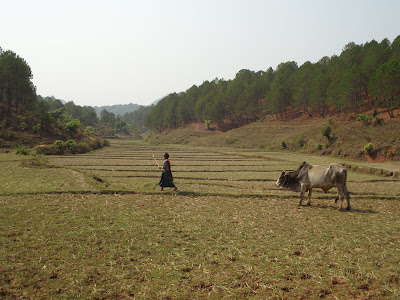
Maybe I just have a negative impression because I arrived knackered and then on the day we left I was sick. I had to turn back from our 3 day trek from Kalaw to Inle Lake, return to Kalaw to rest before taking a bus to meet Monika and the rest of our group at Inle Lake. This trek would have been the first thing I had done in Myanmar that I hadn’t done before (except Mingun) but instead of trekking between villages and rice paddies and fields of grazing buffalo and eating and sleeping in Buddhist monasteries I was sat in my room reading novels by Iris Murdoch and James Hilton. Monika had a good time on the trek though and gave it the thumbs up.
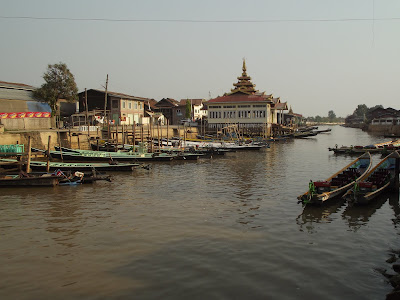
Inle Lake is probably the biggest tourist spot in Myanmar, popular with both locals and foreign tourists. The laid back town of Nyaungshwe just north of the lake is home to dozens of guest houses and restaurants and I must say the place we stayed, Queen Inn, on the opposite side of the small canal from the main town, was a great place to stay – there is a small garden overlooking the canal where you can enjoy a decent breakfast, a choice of pancake breaking the monotony of eggs for breakfast every single day! I don’t think anyone leaves Inle Lake without taking a boat trip to the various sites around the lake. If it is a market day then boats head first to the town of Inthien on the other side of the lake where tribal villagers from all around come to buy and sell their wares and pick-up essential goods and medicines. Close by are a number of ‘workshops’ which all the boats stop at – you can see how silver jewellery is made, or how Burmese cheroot cigarettes are rolled or take a photo of a long-neck tribeswoman making traditional hand-woven scarves (this one felt a little bit staged and exploitative). My favourite was the weaving workshop where they use the long stems of lotus plants as threads as well as seeing traditional silk and cotton weaving methods. It brought a whole new meaning to the bargaining down to $2 for a longyi on the market when you see how much work goes into each one, that is unless you think these days they all get shipped in from Guangzhou and these workshops are just there to con tourists in spending money?!? In any case I became quite attached to a natural lotus scarf, until I saw the price tag - $160. It might have been worth it though; the plants are very rare and can only be harvested at certain times of the year. I bade goodbye to the scarf as we returned across the lake towards Nyaungshwe, stopping at the floating gardens – there are stilt villages on the lake and they grow all their vegetables on floating patches – local menus include ‘Hydroponic salad’ using ingredients from these gardens, the name sounded a bit too weird to order though. The final stop on the boat tour is always at the ‘Jumping Cat’ monastery, where monks have taught cats to jump through small hoops in order to receive fishy treats. A bit kitsch but I think that is the attraction of Inle Lake, a bit like the Cameron Highlands in Malaysia or Monteverde in Costa Rica, these places make the twee suddenly seem really interesting.

There is a well trodden tourist trail through Myanmar that connects Yangon, Bagan, Mandalay and Inle Lake in a diamond that most people visit in one order or another combined with a side trip off in another less travelled direction. Last time I detoured north-east of Mandalay to the hill town of Pyin U Lwin, the trekking centre around Hsipaw and , briefly, the Chinese trading town of Lashio. This time we narrowed it down to a trip into the south-east or visiting one of Myanmar’s upcoming beach resorts. However as the end of our trip coincided with the 10 day Thingyan festival (Burmese New Year, the same as the Thai Songkran water festival) we realised the beaches would be packed and over-priced so we went for a south-east Myanmar detour.
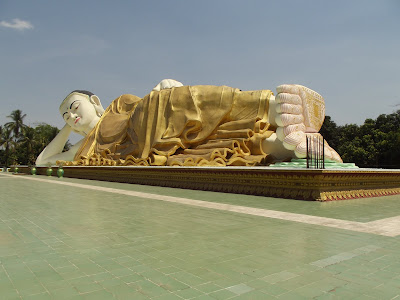
Due to the upcoming New Year’s festival all the private bus companies shut up shop for the entire 10 days leaving people stranded all across the country. We met many people who were preparing for a 10 day stay in Nyaungshwe, preferring to sit it out there rather than brave the streets and try their luck with pick-ups and other forms of transport still running. We were lucky enough to snag two of the last seats on a Yangon-bound bus leaving Inle Lake two days before the start of the festival. We jumped off the bus in Bago, a small town just north of Yangon packed with an incredible number of temples, monasteries and Buddhas strewn in every corner of the town, something like a modern version of Bagan! We arranged a tour with a couple of motorcycle taxi drivers who were able to get us in and around the main sights without paying the $10 government fee. Some of the sights were really impressive – the outdoor reclining Buddha and the garden of Buddhas hidden behind a temple opposite were my highlight as well as the more famous massive Shwemawdaw pagoda looming over the town, one of the biggest and highest in Myanmar and the giant Shwethalyaung reclining Buddha. Later in the day we visited two or three less known temples to the west of town which had some really beautiful whitewashed architecture. I think the attraction of Bago, again similar to Bagan, is that every visitor will visit a different selection of the many sights, but each one is impressive in one way or another.

Obviously there are many differences in all schools of Buddhism but in Myanmar some tenets make it very unique. On the superficial level it is surprising to see monks smoking, drinking, and chewing betel and they are also able to accept money as alms, which is very unusual. There are over half a million monks in Myanmar and every Myanmar male usually takes up monastic residence twice in his life, once as a novice and once as a fully ordained monk. It is quite common to hear guys here saying that they are going to be a monk for a few weeks, almost like a holiday in the monastery! On a more meaningful level is the amalgamation into Buddhism of the nat spirits, remnants of pre-Buddhism beliefs and celebrated and worshipped in an equal way to Buddha himself.
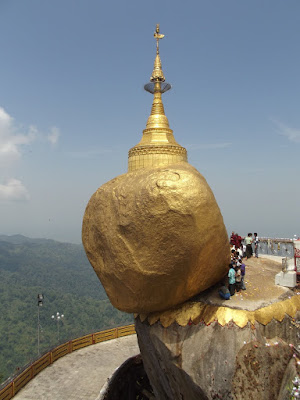
By the time we continued on to Golden Rock the Thingyan festival was in full flow, meaning we were soaked with water by the time we arrived in the village of Kinpun at the base of the rock. Golden Rock is another Buddhist pilgrimage site, a rock topped with a gold stupa covered in gold leaf balanced very precariously atop another rock, although smaller than you imagine it to be it is amazing how it is perfectly balanced there. The Golden Rock is sat at the top of a mountain, which can be accessed by a gruelling 11km walk or by cramming into the back of a big truck with 45 other people and being driven up to a point just 45 minutes walk from the top. The truck ride costs $2 one-way, which if you multiply by 45 people and then double it for a return journey and add a little bit on for the five people in the cab who paid $3 for the privilege means they are raking the money in. Although we were luckily offered a front seat for the price of a space in the back on the way up, by the time we had come down I was glad we only had to cram in the back of the truck one-way! It is the same price here for locals and foreigners alike. Kind of make a mockery of the guys who are collecting donations for the upkeep of the road! After the 45 minute walk from the truck stop you reach a slight hill and the view reveals a long white promenade, full of visitors wandering up and down, taking in the air, taking photos, enjoying drinks and snacks from the vendors. It is rather like a British holiday resort stuck on top a Burmese mountain! During the New Year festival a lot of people spend the whole time up there, sleeping in some of the rudimentary rest house (not open to foreigners) and spending their days relaxing in this manner. Men are allowed to approach the Golden Rock itself and apply new coats of gold leaf (packs of 5 small sheets costing $2), although only some sides are safely accessible which has given the rock a slight bulging appearance.

The Thingyan water festival is the Burmese New Year celebration and lasts for ten days, the exact dates determined by the sighting of the full moon. This year the festival started on 12th April and the water throwing aspect (the liberal dousing of everyone in buckets of water) lasts for four days, or five in Mawlamyine. It is hardest on those that have to travel as each and every pick-up will be sitting targets for the roadside water throwers. Whilst sat in the back of a pick-up you cannot see the water coming, and all of a sudden you will have a bucket thrown into the back, perhaps followed up by a healthy spray from a high pressure hose, all done in good humour though so it is very important not to lose your temper. Everyone has layer upon layer of plastic bags and canvas covers for their valuables in the hope that they can survive the journey. In the towns the local transport shuts down, in the same way as the long distance buses and the entire population of the town roams around, looking to soak or be soaked. Although good fun for a day I found the water throwing aspect quite repetitive and was surprised to see how much enthusiasm people had for getting wet by the third or fourth day. In the weeks leading up to the festival the TV Is full of music videos with a water throwing theme and love stories set around the festival time. Most towns set up big stages where by day people can stand and man the hoses and by night performances of music and dance are put on. At least the festival occurs during the hottest, most humid time of the year (TS Elliot described April as ‘the cruellest month’), so that at times the water was something of a relief.

Our last stop in Myanmar before returning to Yangon was the town of Mawlamyine (formerly Moulmein) in the south-east. This is the third biggest city in the country and previously serve as the capital of British Burma (George Orwell was stationed here during his time in Burma, inspiration for his novel Burmese Days). You would never guess at its past as it is a sleepy town which is separated by a hilly ridge rising through the centre, or at least it is usually sleepy, it really came to life during Thingyan with legions of trucks and motorbikes touring around the town, along the Strand pouring water on each other and gleefully stopping under the platform where small children doused the vehicles with water from hoses. There are a number of pagodas on the ridge that overlook the town and the Thanlwin river and following in the literary theme this was the setting for the opening lines of Kipling’s poem ‘Mandalay’ – “By the old Moulmein pagoda, lookin lazy at the sea”.

There are a few interesting places to visit around Mawlamyine as well. We hired a motorbike for a day and set out. We stopped at the limestone crags of Kyauktalon Taung on the way to the 170m reclining Buddha at Win Sein Taw Ya, one of the largest religious images in the world. It takes the kitsch aspect of Buddhism to a new level with a stairway leading into Buddha’s head; inside over three floors covering the entire interior space are a range of galleries depicting some sort of ‘House of Horror’ scenes, a gory sight to be seen inside of peaceful Buddha! Further south close to the town of Thanbyuzayat is the Burmese terminus of the Death Railway, constructed by Japan during World War II. Having visited the POW camp at Changi and the other end of the railway at the River Kwai I was looking forward to seeing the cemetery and memorial here. Unfortunately we had a couple of mechanical issues with the bike – a busted spark plug and a burst rear tyre which delayed us and also sowed a seed of doubt in our mind. Coupled with the stress of being drenched in buckets of water as we were riding along we did not fancy heading too far from Mawlamyine and not getting back, so unfortunately we never made it to Thanbyuzayat. We did stop in the peaceful meditation retreat at the Pa-Auk-Taw-Ya Monastery on the way back to the town, a great place to get some quiet respite from the madness of the streets.

With the buses all still out of action we were forced to take the train back to Yangon. We went for the ‘Ordinary’ class which means wooden benches with upright backs for the 11 hour journey through the night. Travelling in Myanmar can be hard work and the only thing that got me though the night was the thought that this was our last journey before flying back to Bangkok. We just had time for a couple of days to recover in Yangon, a bit of souvenir shopping in the Bogyoke Aung San market and a final visit to our favourite places – New Delhi restaurant for the dosai, 999 Shan for the noodle soup and tofu, Nilar Cafe for the biryani and Aung Restaurant for draft Myanmar beer! There was also time for two more examples of the incredible Burmese hospitality – firstly when I asked a taxi driver if he could take us to the airport in a couple of days time and he said he could but due to some petrol issue he has to charge $2 more than the going rate so he advised me to find another driver, the second experience was when we shared a table at the Aung restaurant with a guy from Rakhaing state, in the north-west, and after a very brief conversation in broken English he whipped out a stack of 1000 kyat notes and paid our tab for us, and bought me some crisps as well!
